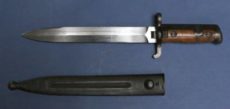Norway
Norway history of 19th century is not violent at all. After turmoil of Napoleonic wars it was separated from Denemark and as a kingdom entered a period of personal union with Sweden. Nevertheless is had its own autonomy, parliament and evolved as many leading European countries. It’s military development was separate from Swedish, though somehow parallel. Kammerlader rifles appeared in both armies, also some bayonets were similar.
Union with Sweden finally dissolved in 1905.From then Norway adopted the policy of neutrality, but during WWI dealed mainly with Britain. Many Norwegian mariners lost their lives in U-boot attacks.
Norway produced a nice variety of bayonets, which are not widely known. But fortunately there is an excellent source of information – the page of Per Holmback (www.holmback.se). Very distinctive 19th century yatagans that came from Norway were model 1851 – a huge blade with unique one piece wooden hilt. Another was model 1860 yatagan with variants, also used with kammerladers. Then emerged two constructions for Jarman rifles – one epee, and other marine knife bayonet. Both are extremly hard to find. Short knife version has been also modified by Germans during WWII.
 M1851 – Huge yatagan of unique wooden hilt and catch construction. Really rare. The scabbard was leather with brass fittings but probably there are a few preserved.
M1851 – Huge yatagan of unique wooden hilt and catch construction. Really rare. The scabbard was leather with brass fittings but probably there are a few preserved.
 Yatagan for kammerladder M1860, rifles 1860 and 1860/67 and Remington 1867. Brass hilt with wooden grips. This one is in beautiful, virgin patinated condition with nicely preserved scabbard.
Yatagan for kammerladder M1860, rifles 1860 and 1860/67 and Remington 1867. Brass hilt with wooden grips. This one is in beautiful, virgin patinated condition with nicely preserved scabbard.
 M1859 bayonet for Kammerlader (chamber loaded) rifle. Almost identical with the above one, but with slightly wider barrel ring (over 23mm)
M1859 bayonet for Kammerlader (chamber loaded) rifle. Almost identical with the above one, but with slightly wider barrel ring (over 23mm)
 Bayonet for Krag -Jorgenssen rifle M1912. It is a derivate of long experimantal bayonet, which had been shortened because of fagility of the blade. That’s why fullers run to the end of the bayonet. Early leather scabbard with integral frog.
Bayonet for Krag -Jorgenssen rifle M1912. It is a derivate of long experimantal bayonet, which had been shortened because of fagility of the blade. That’s why fullers run to the end of the bayonet. Early leather scabbard with integral frog.
 M1916 Krag -Jorgenssen bayonet. Unique design, similar to Danish constructions – one piece blade and hilt with wooden grips. One of the kind oblique frog. Nice, original shape. Some early examples had leather scabbard.
M1916 Krag -Jorgenssen bayonet. Unique design, similar to Danish constructions – one piece blade and hilt with wooden grips. One of the kind oblique frog. Nice, original shape. Some early examples had leather scabbard.
 Common Norwegian knife bayonet. They were manufactured by OEWG (like this one), Konsberg and Husgvarna (only 2000). After WWII some were adopted for M1 carabine. Unique frog is much less common and expensive then the bayonet itself. The blade is roughly sharpened, which is often seen in thiese bayonets.
Common Norwegian knife bayonet. They were manufactured by OEWG (like this one), Konsberg and Husgvarna (only 2000). After WWII some were adopted for M1 carabine. Unique frog is much less common and expensive then the bayonet itself. The blade is roughly sharpened, which is often seen in thiese bayonets.
 Bayonet produced in Sweden during WWII for Norwegian Resistance or police forced that were organized in opposition to collaborating Norwegian authorities. The unit had beed armed with Krag-Jorgensen rifles deposited in Sweden at the beginning of WWII when I Infantry Division was interned. Byonets for them were lost in burned magazines. 4600 of these bayonets had been manufactured, first 20 had no serial numbers. Nicely made bayonnet, corresponding in design to Swedish M1896.
Bayonet produced in Sweden during WWII for Norwegian Resistance or police forced that were organized in opposition to collaborating Norwegian authorities. The unit had beed armed with Krag-Jorgensen rifles deposited in Sweden at the beginning of WWII when I Infantry Division was interned. Byonets for them were lost in burned magazines. 4600 of these bayonets had been manufactured, first 20 had no serial numbers. Nicely made bayonnet, corresponding in design to Swedish M1896.
 Short Krag bayonet M1894 adapted for american M1.
Short Krag bayonet M1894 adapted for american M1.
 Another example of norwegian adaptation for M1 rifle. This is German 84/98 aquired after WWII. German waffenamts are preserved.
Another example of norwegian adaptation for M1 rifle. This is German 84/98 aquired after WWII. German waffenamts are preserved.
The most abundant Norwegian bayonets are both versions for Krag rifle, especially the short one. It was manufactured in Norway and by OEWG, used for many years since 1894, modified by Germans during their occupationa and after the war even adapted for M1
Showing all 15 results












